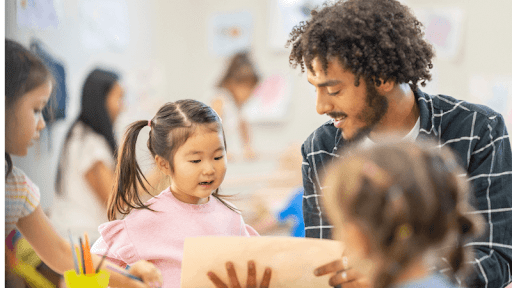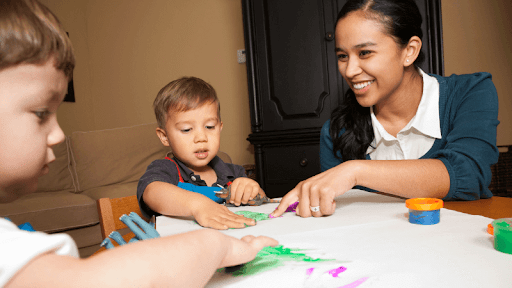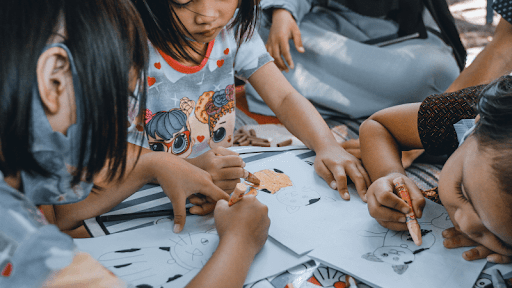What are the Three I's in Early Years
Intent, implementation and impact
Early years education is a crucial time for children’s development and lays the foundation for their future academic success. To ensure that early years education is effective, it is essential to consider the three I’s in early years: intent, implementation, and impact. We will explore each of these I’s and their significance in early years education.
Ofsted uses the three i’s framework as part of its inspections to evaluate the quality of a school’s curriculum. The judgment of the curriculum is made using these focus areas, so it is important for schools to get them right. In order to design a strong curriculum that can be judged as Outstanding, schools need to focus on these three key areas.
The “three i’s” in the context of the Early Years Foundation Stage (EYFS) refer to a framework used to assess the quality of early years education.

Intent
 Intent is a critical component of any successful educational program, including early years education. Nursery practitioners must have a clear understanding of their goals and objectives to provide a purposeful and effective learning experience for young children. Setting clear goals and objectives helps educators identify the skills and knowledge they want their students to gain from the curriculum.
Intent is a critical component of any successful educational program, including early years education. Nursery practitioners must have a clear understanding of their goals and objectives to provide a purposeful and effective learning experience for young children. Setting clear goals and objectives helps educators identify the skills and knowledge they want their students to gain from the curriculum.
Learning goals are specific, measurable statements that help design a course and assess its success. These goals help educators determine what they want their students to know and be able to do at the end of the course. Setting learning goals provides a roadmap for educators, helps to prioritize course content, and creates a framework for evaluating student achievement.
In early years education, the intent should be to provide a stimulating and safe environment that fosters the development of children’s cognitive, social, emotional, and physical skills. Nursery practitioners should aim to create a curriculum that is responsive to the changing needs and interests of children, with clearly defined learning goals. These goals should be age-appropriate and based on a deep understanding of child development, providing opportunities for children to explore, experiment, and learn through play.
Having a clear intent in early years education can help nursery practitioners design a meaningful and purposeful curriculum that meets the needs of each child. It also provides a framework for assessment, enabling nursery practitioners to evaluate the effectiveness of their teaching strategies and adapt their approach to meet the changing needs of their students. Ultimately, having a clear intent helps to ensure that young children receive a high-quality education that prepares them for success in their future academic and personal lives.
Implementation
 In the context of early years education, implementation is the process of translating the early years curriculum’s intent into a practical plan that can be implemented by nursery practitioners.
In the context of early years education, implementation is the process of translating the early years curriculum’s intent into a practical plan that can be implemented by nursery practitioners.
Effective implementation requires nursery practitioners to ensure that their teaching methods align with their intent and that children are actively engaged and motivated to learn. This involves creating a safe and stimulating learning environment that fosters the development of children’s cognitive, social, emotional, and physical skills. Nursery practitioners should develop age-appropriate activities that are designed to support each child’s unique learning needs, interests, and abilities.
To ensure that children’s needs and interests are met, nursery practitioners should use effective teaching strategies that promote active learning, critical thinking, and problem-solving. Effective teaching strategies can include hands-on learning experiences, group work, and play-based learning. Nursery practitioners should also use assessment methods to monitor children’s progress and identify areas where improvements can be made.
Implementing a curriculum effectively requires ongoing nursery practitioner professional development and support. This can include in-service training, the development of new textbooks and teaching materials, and fostering a nursery culture that supports ongoing development and improvement.
Effective implementation of a curriculum is essential in early years education. Nursery practitioners need to ensure that their teaching methods align with the curriculum’s intent and that children are actively engaged and motivated to learn. This requires creating a safe and stimulating learning environment, developing age-appropriate activities, and using effective teaching strategies. By focusing on effective implementation, early years educators can provide children with a high-quality learning experience that sets them up for success in their future academic and personal lives.
Impact
 To evaluate the impact of early years education, nursery practitioners must use observation and assessment methods to monitor children’s progress and identify areas where improvements can be made.
To evaluate the impact of early years education, nursery practitioners must use observation and assessment methods to monitor children’s progress and identify areas where improvements can be made.
Effective impact evaluation helps nursery practitioners to adapt their teaching methods to meet the changing needs of children and improve learning outcomes. For example, research indicates that early child care and education may lead to improvements in short- and long-term health-related outcomes for children. By evaluating the impact of early years education, nursery practitioners can identify areas where they can further promote children’s physical, social, emotional, and cognitive development.
Impact evaluation also plays a critical role in informing decision-making and program improvement. By using data-driven insights, teachers can identify areas of strength and weakness in their curriculum and make evidence-based decisions to improve teaching and learning outcomes. For example, if impact evaluation reveals that certain teaching strategies are not effective, nursery practitioners can make adjustments to their approach to better meet the needs of their students.
Prime And Specific Areas Of Learning
 The three Prime Areas of learning are fundamental to a child’s development in their early years. They provide a strong foundation for children to build upon as they progress through their education.
The three Prime Areas of learning are fundamental to a child’s development in their early years. They provide a strong foundation for children to build upon as they progress through their education.
Communication and Language
Developing strong communication and language skills in young children is essential for their overall development and future success in nurseries and beyond. In early years education, nursery practitioners can help children develop these skills by providing a language-rich environment, engaging in conversations with them, reading to them regularly, and encouraging them to express themselves through creative activities like drawing and storytelling. By focusing on Communication and Language as a prime area of learning, this can help children build a solid foundation for effective communication and language skills that will benefit them throughout their lives.
Physical Development
Physical development is a crucial area of learning that focuses on a child’s physical abilities and motor skills. It includes both gross motor skills and fine motor skills. Gross motor skills refer to the movements that involve larger muscles, such as those in the arms and legs, and the whole body, such as crawling, walking, running, jumping, and throwing. These skills are developed from infancy, starting with gaining control of the head, neck, and torso to achieve a sitting or standing position. They are further developed in the toddler years with locomotor skills such as walking, running, jumping, and stretching.
Fine motor skills, on the other hand, refer to the movements that involve smaller muscles, such as those in the fingers, hands, and wrists. They include activities such as writing, drawing, cutting, and manipulating small objects. Developing fine motor skills is essential for a child’s success in a nursery and daily activities.
Physical development also involves promoting a healthy lifestyle, such as developing good eating habits and encouraging regular exercise. Early childhood is an excellent time to establish healthy habits that can carry into adulthood. Healthy eating habits can be promoted through exposing children to a variety of nutritious foods and modeling healthy eating habits. Regular physical activity can be encouraged through activities such as outdoor play, sports, and structured physical education activities.
Personal, Social and Emotional Development
Personal, Social, and Emotional Development is an essential area of learning that aims to develop a child’s self-awareness, self-esteem, and emotional well-being. It is crucial for children to learn how to manage their emotions, express themselves effectively, and develop a positive sense of self. This area of learning aims to promote the development of social skills and positive relationships with others. Children are taught how to communicate with others effectively, work collaboratively, and develop empathy towards their peers.
One critical aspect of personal, social, and emotional development is the development of emotional literacy. Emotional literacy refers to the ability to identify and understand one’s emotions and the emotions of others. Children are taught how to recognize different emotions and how to express their feelings effectively. This is important in developing their self-esteem, as well as their ability to develop positive relationships with others.
Another crucial component of personal, social, and emotional development is developing a sense of community and social responsibility. Children are taught how to work collaboratively with others towards common goals, to respect others’ opinions and beliefs, and to appreciate diversity. This promotes a sense of belonging and encourages children to become responsible members of their communities.
The four Specific Areas of learning are:
Literacy
This area of learning focuses on developing a child’s ability to read and write. This includes developing their phonics skills, their ability to recognize and write letters and words, and their comprehension skills.
Mathematics
This area of learning focuses on developing a child’s mathematical skills, including counting, adding, subtracting, and recognizing shapes and patterns.
Understanding the World
This area of learning focuses on developing a child’s understanding of the world around them. This includes developing their knowledge of different cultures, communities, and environments, as well as their understanding of technology and science.
Expressive Arts and Design
This area of learning focuses on developing a child’s creativity and imagination. This includes developing their ability to express themselves through art, music, and dance, as well as developing their understanding of design and technology.
Conclusion
In conclusion, the three I’s of intent, implementation, and impact are crucial in early years education. Nursery practitioners need to have a clear intent for their curriculum, implement it effectively, and evaluate its impact to ensure that children are provided with a high-quality learning experience that sets them up for future success. By considering these three I’s, we can ensure that early years education is meaningful, purposeful, and effective.
FREQUENTLY ASKED QUESTIONS
Q. What is intent in early years education?
A. Intent in early years education refers to the overall purpose and goals of the curriculum. Nursery practitioners must have a clear understanding of what they want to achieve through their teaching and how they plan to achieve it. This involves setting goals and creating a curriculum that is responsive to the changing needs of children.
Q. What is implementation in early years education?
A. Implementation in early years education refers to how the curriculum is put into practice. Nursery practitioners need to ensure that their teaching methods align with their intent and that children are engaged and motivated to learn. This involves creating a safe and stimulating learning environment, developing age-appropriate activities, and using effective teaching strategies.
Q. What is impact in early years education?
A. Impact in early years education refers to the outcomes of the curriculum. Nursery practitioners need to evaluate whether their curriculum has been effective in achieving its intended goals. This involves using observation and assessment methods to monitor children’s progress and identify areas where improvements can be made. Effective impact evaluation ensures that nursery practitioners can adapt their teaching methods to meet the changing needs of children and improve learning outcomes.
Q. Why are the three I’s important in early years education?
A. The three I’s of intent, implementation, and impact are essential components of a high-quality curriculum in early years education. By having a clear intent, effective implementation, and impactful evaluation, educators can provide a meaningful and purposeful learning experience for young children.
Q. How can nursery practitioners ensure effective implementation in early years education?
A. Effective implementation in early years education requires nursery practitioners to ensure that their teaching methods align with their intent and that children are actively engaged and motivated to learn. This involves creating a safe and stimulating learning environment, developing age-appropriate activities, and using effective teaching strategies.
Q. What methods can nursery practitioners use to evaluate impact in early years education?
A. To evaluate the impact of early years education, they can use observation and assessment methods to monitor children’s progress and identify areas where improvements can be made. Effective impact evaluation ensures that they can adapt their teaching methods to meet the changing needs of children and improve learning outcomes.
Q. How can intent be translated into effective implementation in early years education?
A. To translate intent into effective implementation in early years education, nursery practitioners must ensure that their teaching methods align with their goals and objectives. This involves creating a safe and stimulating learning environment, developing age-appropriate activities, and using effective teaching strategies.
Q. How can nursery practitioners adapt their teaching methods based on impact evaluation in early years education?
A. Based on impact evaluation, they can identify areas where they can further promote children’s physical, social, emotional, and cognitive development.



